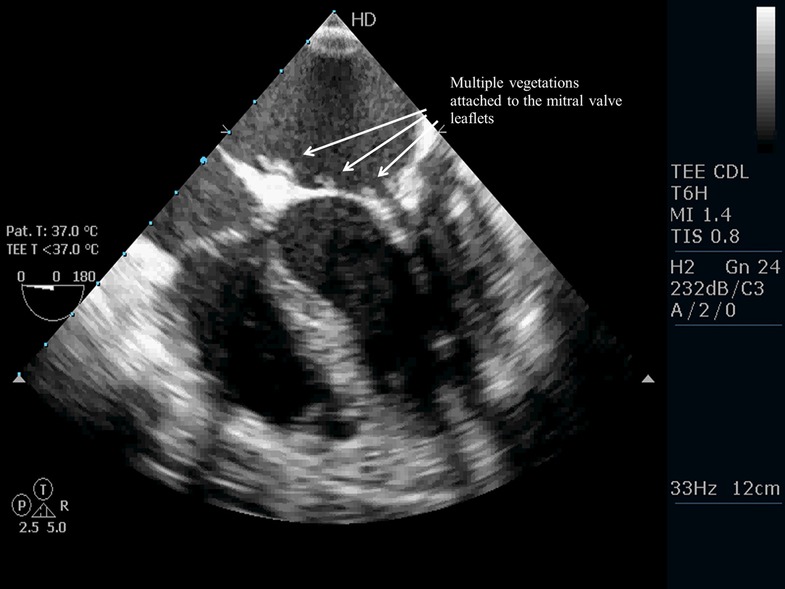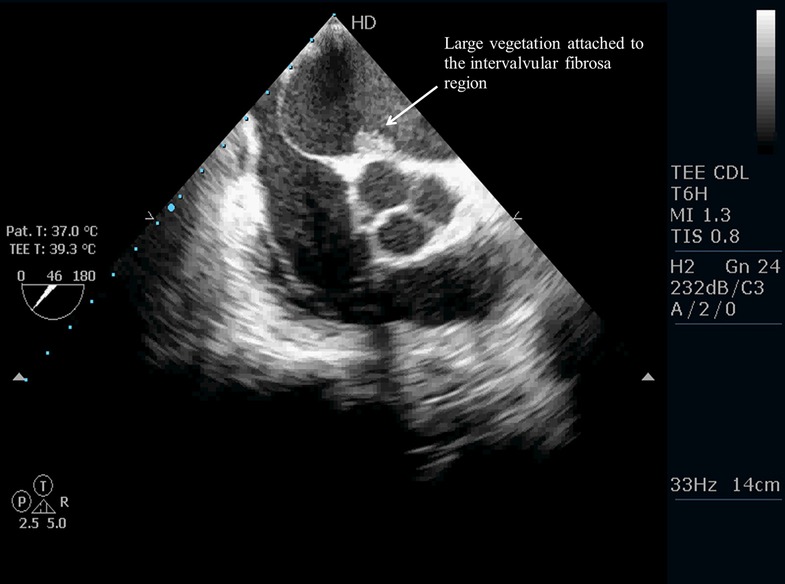Description
We present images of a 35-year-old man with rheumatic mitral regurgitation. The patient presented with a 1 month history of continuous fever, worsened exertional dyspnoea and orthopnoea. With a clinical suspicion of infective endocarditis, the patient initially underwent a transthoracic echocardiogram, which revealed the possibility of vegetations attached to the mitral leaflets, though not definitively. In order to confirm the diagnosis, the patient was subjected to a transoesophageal echocardiogram, which showed an astounding image having multiple vegetations apparently dancing in unison on both mitral leaflets (figure 1, videos 1 and 2) and also attached to the intervalvular fibrosa (figure 2, video 3) region, sparing the aortic valve.
Figure 1.

Multiple vegetations attached to both mitral valve leaflets.
Figure 2.

Large vegetation attached to intervalvular fibrosa region with sparing of the aortic valve.
This patient was hospitalised, and all the blood cultures consistently revealed the presence of a rare organism Kocuria rosea, which is a Gram-positive, coagulase-negative, coccoid actinobacteria belonging to the family Micrococcaceae, which is considered atypical for endocarditis. It is primarily isolated from soil and water, and has been implicated in occasional urinary tract infections in immune compromised patients.1 The patient was subsequently treated with 4 weeks of parenteral gentamycin and ceftriaxone, to which the organism had grown sensitive to in the blood cultures, during which his symptoms of orthopnoea and dyspnoea improved and there were no thromboembolic complications. He was subsequently planned for elective mitral valve replacement on follow-up.
Presence of vegetation is a diagnostic and prognostic marker of endocarditis, and this patient had vegetations in ‘all shapes and sizes’–– with San Fillipo grade 3 mobility, grade 4 consistency and grade 4 extent, which essentially predicts a poor prognosis and high risk of embolic complications, but luckily for us in this case the treatment and final outcome was successful.
The presence of multiple vegetations apparently ‘dancing in unison’ in a case of native valve endocarditis caused by a rare organism makes the case unique.
Learning points.
Infective endocarditis forms a potentially lethal complication of structural valvular heart disease.
Vegetations form a diagnostic and prognostic marker for management.
Appropriate medical management and observation can lead to successful outcome even in complicated cases.
Footnotes
Contributors: All the authors have contributed to the drafting of the manuscript, and worked for patient care.
Competing interests: None.
Patient consent: Obtained.
Provenance and peer review: Not commissioned; externally peer reviewed.
Reference
- 1.Savini V, Catavitello C, Masciarelli G, et al. Drug sensitivity and clinical impact of members of the genus Kocuria. J Med Microbiol 2010;2013:1395–402 [DOI] [PubMed] [Google Scholar]
Associated Data
This section collects any data citations, data availability statements, or supplementary materials included in this article.


